check engine JEEP RENEGADE 2018 Owner handbook (in English)
[x] Cancel search | Manufacturer: JEEP, Model Year: 2018, Model line: RENEGADE, Model: JEEP RENEGADE 2018Pages: 356, PDF Size: 6.11 MB
Page 20 of 356
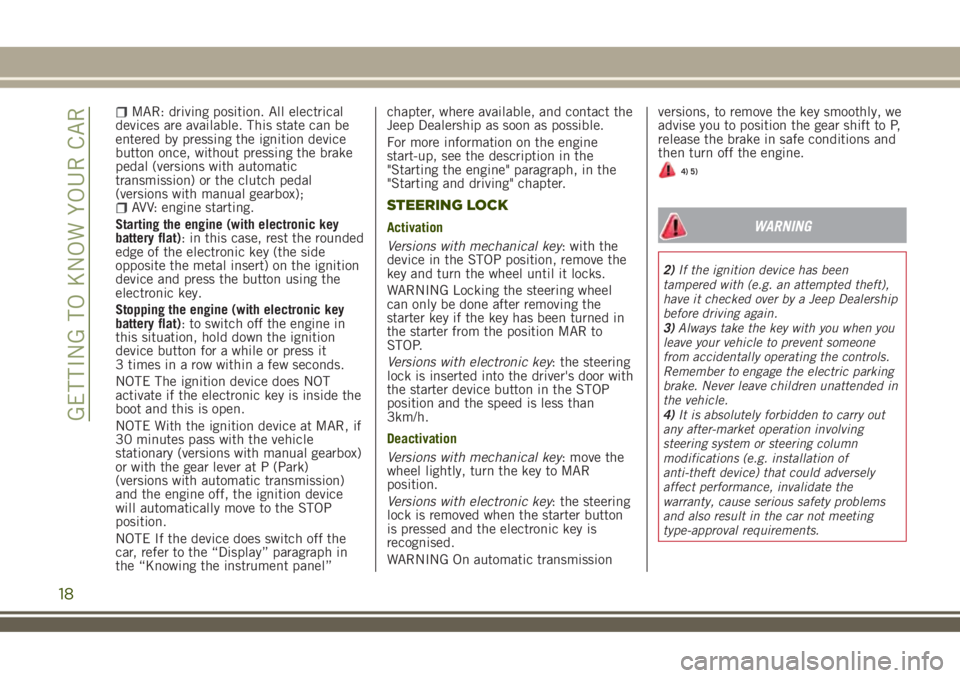
MAR: driving position. All electrical
devices are available. This state can be
entered by pressing the ignition device
button once, without pressing the brake
pedal (versions with automatic
transmission) or the clutch pedal
(versions with manual gearbox);
AVV: engine starting.
Starting the engine (with electronic key
battery flat): in this case, rest the rounded
edge of the electronic key (the side
opposite the metal insert) on the ignition
device and press the button using the
electronic key.
Stopping the engine (with electronic key
battery flat): to switch off the engine in
this situation, hold down the ignition
device button for a while or press it
3 times in a row within a few seconds.
NOTE The ignition device does NOT
activate if the electronic key is inside the
boot and this is open.
NOTE With the ignition device at MAR, if
30 minutes pass with the vehicle
stationary (versions with manual gearbox)
or with the gear lever at P (Park)
(versions with automatic transmission)
and the engine off, the ignition device
will automatically move to the STOP
position.
NOTE If the device does switch off the
car, refer to the “Display” paragraph in
the “Knowing the instrument panel”chapter, where available, and contact the
Jeep Dealership as soon as possible.
For more information on the engine
start-up, see the description in the
"Starting the engine" paragraph, in the
"Starting and driving" chapter.STEERING LOCK
Activation
Versions with mechanical key: with the
device in the STOP position, remove the
key and turn the wheel until it locks.
WARNING Locking the steering wheel
can only be done after removing the
starter key if the key has been turned in
the starter from the position MAR to
STOP.
Versions with electronic key: the steering
lock is inserted into the driver's door with
the starter device button in the STOP
position and the speed is less than
3km/h.
Deactivation
Versions with mechanical key: move the
wheel lightly, turn the key to MAR
position.
Versions with electronic key: the steering
lock is removed when the starter button
is pressed and the electronic key is
recognised.
WARNING On automatic transmissionversions, to remove the key smoothly, we
advise you to position the gear shift to P,
release the brake in safe conditions and
then turn off the engine.
4) 5)
WARNING
2)If the ignition device has been
tampered with (e.g. an attempted theft),
have it checked over by a Jeep Dealership
before driving again.
3)Always take the key with you when you
leave your vehicle to prevent someone
from accidentally operating the controls.
Remember to engage the electric parking
brake. Never leave children unattended in
the vehicle.
4)It is absolutely forbidden to carry out
any after-market operation involving
steering system or steering column
modifications (e.g. installation of
anti-theft device) that could adversely
affect performance, invalidate the
warranty, cause serious safety problems
and also result in the car not meeting
type-approval requirements.
18
GETTING TO KNOW YOUR CAR
Page 24 of 356
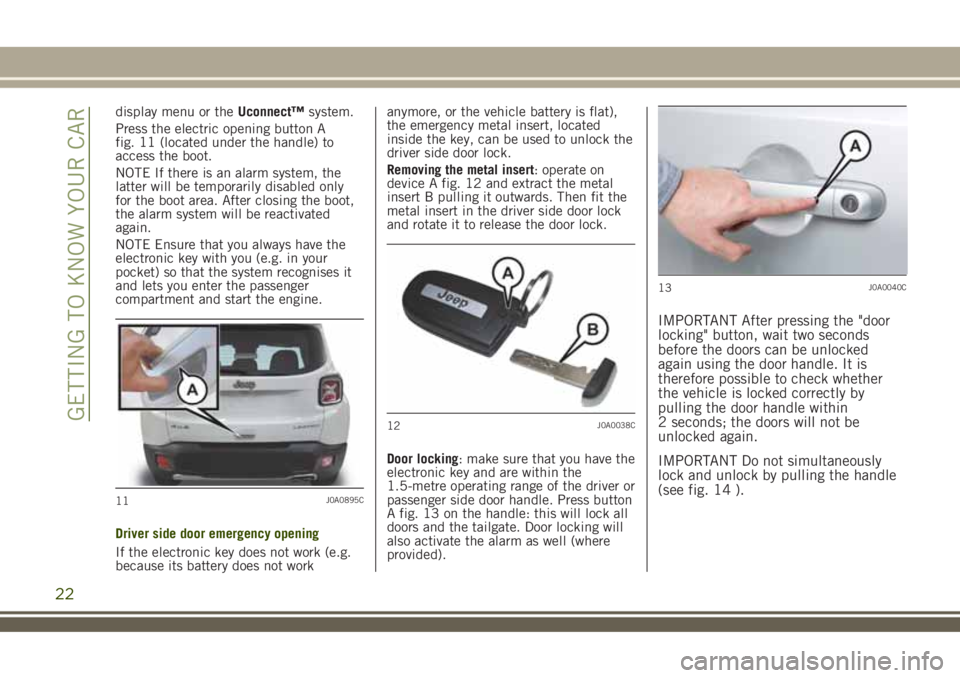
display menu or theUconnect™system.
Press the electric opening button A
fig. 11 (located under the handle) to
access the boot.
NOTE If there is an alarm system, the
latter will be temporarily disabled only
for the boot area. After closing the boot,
the alarm system will be reactivated
again.
NOTE Ensure that you always have the
electronic key with you (e.g. in your
pocket) so that the system recognises it
and lets you enter the passenger
compartment and start the engine.
Driver side door emergency opening
If the electronic key does not work (e.g.
because its battery does not workanymore, or the vehicle battery is flat),
the emergency metal insert, located
inside the key, can be used to unlock the
driver side door lock.
Removing the metal insert: operate on
device A fig. 12 and extract the metal
insert B pulling it outwards. Then fit the
metal insert in the driver side door lock
and rotate it to release the door lock.
Door locking: make sure that you have the
electronic key and are within the
1.5-metre operating range of the driver or
passenger side door handle. Press button
A fig. 13 on the handle: this will lock all
doors and the tailgate. Door locking will
also activate the alarm as well (where
provided).
IMPORTANT After pressing the "door
locking" button, wait two seconds
before the doors can be unlocked
again using the door handle. It is
therefore possible to check whether
the vehicle is locked correctly by
pulling the door handle within
2 seconds; the doors will not be
unlocked again.
IMPORTANT Do not simultaneously
lock and unlock by pulling the handle
(see fig. 14 ).
11J0A0895C
12J0A0038C
13J0A0040C
22
GETTING TO KNOW YOUR CAR
Page 28 of 356
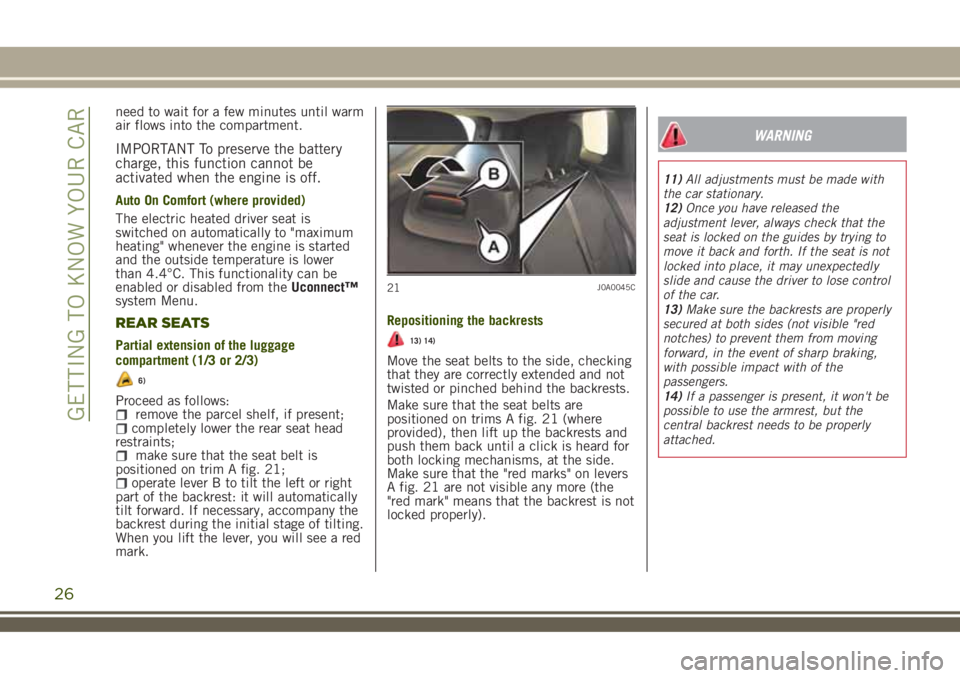
need to wait for a few minutes until warm
air flows into the compartment.
IMPORTANT To preserve the battery
charge, this function cannot be
activated when the engine is off.
Auto On Comfort (where provided)
The electric heated driver seat is
switched on automatically to "maximum
heating" whenever the engine is started
and the outside temperature is lower
than 4.4°C. This functionality can be
enabled or disabled from theUconnect™
system Menu.
REAR SEATS
Partial extension of the luggage
compartment (1/3 or 2/3)
6)
Proceed as follows:remove the parcel shelf, if present;completely lower the rear seat head
restraints;
make sure that the seat belt is
positioned on trim A fig. 21;
operate lever B to tilt the left or right
part of the backrest: it will automatically
tilt forward. If necessary, accompany the
backrest during the initial stage of tilting.
When you lift the lever, you will see a red
mark.Repositioning the backrests
13) 14)
Move the seat belts to the side, checking
that they are correctly extended and not
twisted or pinched behind the backrests.
Make sure that the seat belts are
positioned on trims A fig. 21 (where
provided), then lift up the backrests and
push them back until a click is heard for
both locking mechanisms, at the side.
Make sure that the "red marks" on levers
A fig. 21 are not visible any more (the
"red mark" means that the backrest is not
locked properly).
WARNING
11)All adjustments must be made with
the car stationary.
12)Once you have released the
adjustment lever, always check that the
seat is locked on the guides by trying to
move it back and forth. If the seat is not
locked into place, it may unexpectedly
slide and cause the driver to lose control
of the car.
13)Make sure the backrests are properly
secured at both sides (not visible "red
notches) to prevent them from moving
forward, in the event of sharp braking,
with possible impact with of the
passengers.
14)If a passenger is present, it won't be
possible to use the armrest, but the
central backrest needs to be properly
attached.
21J0A0045C
26
GETTING TO KNOW YOUR CAR
Page 55 of 356
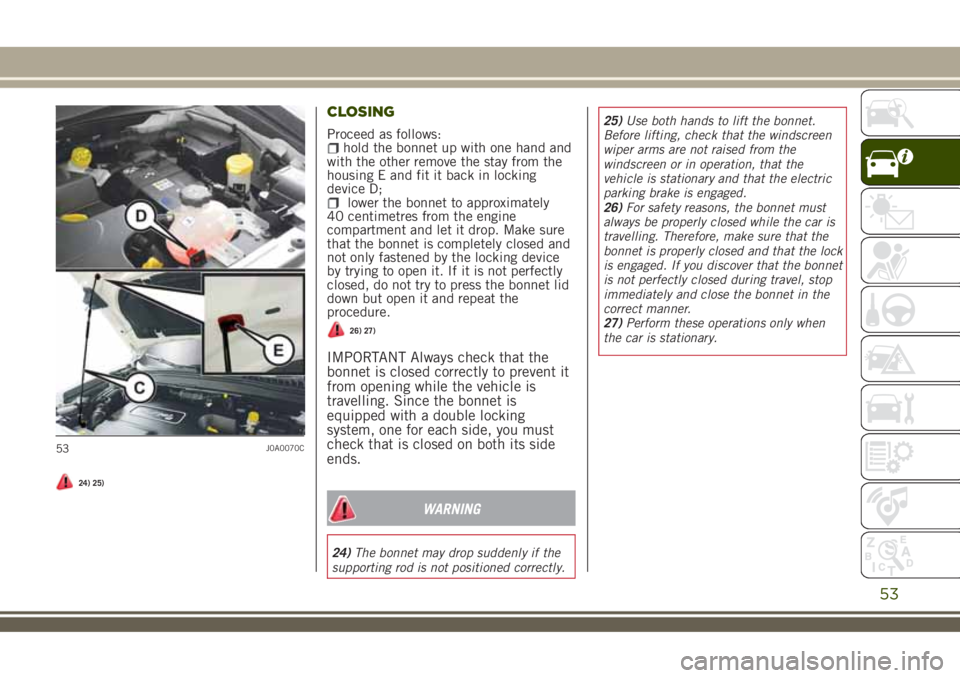
24) 25)
CLOSING
Proceed as follows:hold the bonnet up with one hand and
with the other remove the stay from the
housing E and fit it back in locking
device D;
lower the bonnet to approximately
40 centimetres from the engine
compartment and let it drop. Make sure
that the bonnet is completely closed and
not only fastened by the locking device
by trying to open it. If it is not perfectly
closed, do not try to press the bonnet lid
down but open it and repeat the
procedure.
26) 27)
IMPORTANT Always check that the
bonnet is closed correctly to prevent it
from opening while the vehicle is
travelling. Since the bonnet is
equipped with a double locking
system, one for each side, you must
check that is closed on both its side
ends.
WARNING
24)The bonnet may drop suddenly if the
supporting rod is not positioned correctly.25)Use both hands to lift the bonnet.
Before lifting, check that the windscreen
wiper arms are not raised from the
windscreen or in operation, that the
vehicle is stationary and that the electric
parking brake is engaged.
26)For safety reasons, the bonnet must
always be properly closed while the car is
travelling. Therefore, make sure that the
bonnet is properly closed and that the lock
is engaged. If you discover that the bonnet
is not perfectly closed during travel, stop
immediately and close the bonnet in the
correct manner.
27)Perform these operations only when
the car is stationary.
53J0A0070C
53
Page 60 of 356
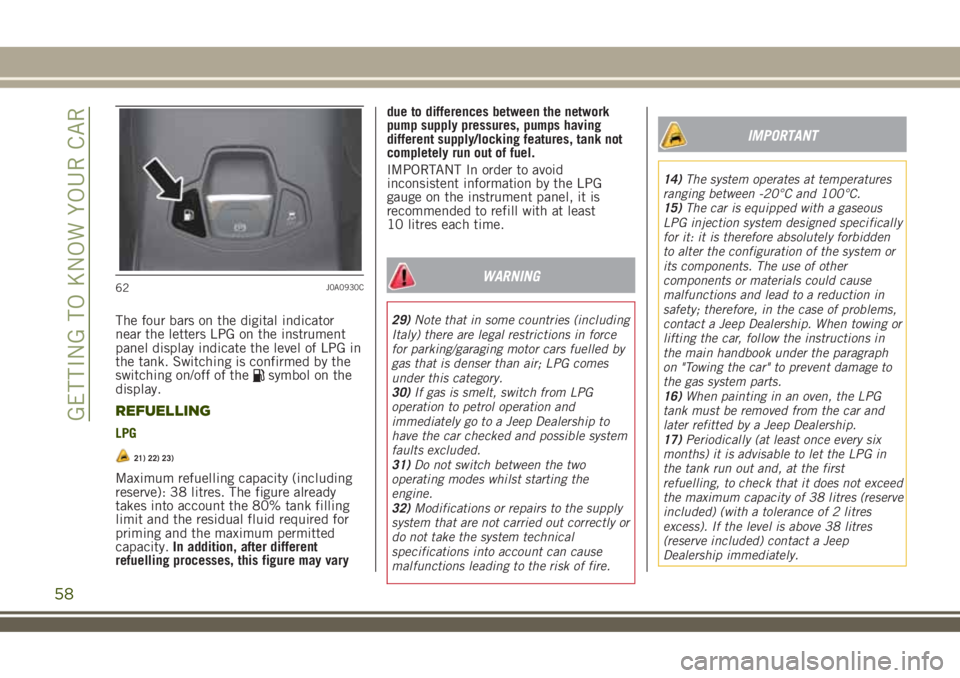
The four bars on the digital indicator
near the letters LPG on the instrument
panel display indicate the level of LPG in
the tank. Switching is confirmed by the
switching on/off of the
symbol on the
display.
REFUELLING
LPG
21) 22) 23)
Maximum refuelling capacity (including
reserve): 38 litres. The figure already
takes into account the 80% tank filling
limit and the residual fluid required for
priming and the maximum permitted
capacity.In addition, after different
refuelling processes, this figure may varydue to differences between the network
pump supply pressures, pumps having
different supply/locking features, tank not
completely run out of fuel.
IMPORTANT In order to avoid
inconsistent information by the LPG
gauge on the instrument panel, it is
recommended to refill with at least
10 litres each time.
WARNING
29)Note that in some countries (including
Italy) there are legal restrictions in force
for parking/garaging motor cars fuelled by
gas that is denser than air; LPG comes
under this category.
30)If gas is smelt, switch from LPG
operation to petrol operation and
immediately go to a Jeep Dealership to
have the car checked and possible system
faults excluded.
31)Do not switch between the two
operating modes whilst starting the
engine.
32)Modifications or repairs to the supply
system that are not carried out correctly or
do not take the system technical
specifications into account can cause
malfunctions leading to the risk of fire.
IMPORTANT
14)The system operates at temperatures
ranging between -20°C and 100°C.
15)The car is equipped with a gaseous
LPG injection system designed specifically
for it: it is therefore absolutely forbidden
to alter the configuration of the system or
its components. The use of other
components or materials could cause
malfunctions and lead to a reduction in
safety; therefore, in the case of problems,
contact a Jeep Dealership. When towing or
lifting the car, follow the instructions in
the main handbook under the paragraph
on "Towing the car" to prevent damage to
the gas system parts.
16)When painting in an oven, the LPG
tank must be removed from the car and
later refitted by a Jeep Dealership.
17)Periodically (at least once every six
months) it is advisable to let the LPG in
the tank run out and, at the first
refuelling, to check that it does not exceed
the maximum capacity of 38 litres (reserve
included) (with a tolerance of 2 litres
excess). If the level is above 38 litres
(reserve included) contact a Jeep
Dealership immediately.
62J0A0930C
58
GETTING TO KNOW YOUR CAR
Page 61 of 356
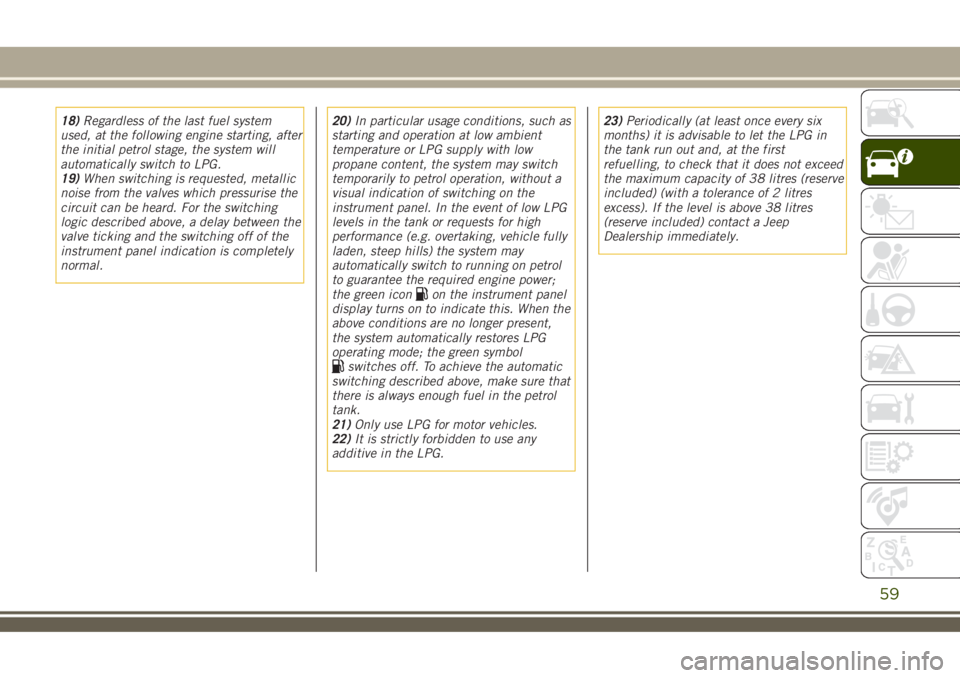
18)Regardless of the last fuel system
used, at the following engine starting, after
the initial petrol stage, the system will
automatically switch to LPG.
19)When switching is requested, metallic
noise from the valves which pressurise the
circuit can be heard. For the switching
logic described above, a delay between the
valve ticking and the switching off of the
instrument panel indication is completely
normal.20)In particular usage conditions, such as
starting and operation at low ambient
temperature or LPG supply with low
propane content, the system may switch
temporarily to petrol operation, without a
visual indication of switching on the
instrument panel. In the event of low LPG
levels in the tank or requests for high
performance (e.g. overtaking, vehicle fully
laden, steep hills) the system may
automatically switch to running on petrol
to guarantee the required engine power;
the green icon
on the instrument panel
display turns on to indicate this. When the
above conditions are no longer present,
the system automatically restores LPG
operating mode; the green symbol
switches off. To achieve the automatic
switching described above, make sure that
there is always enough fuel in the petrol
tank.
21)Only use LPG for motor vehicles.
22)It is strictly forbidden to use any
additive in the LPG.23)Periodically (at least once every six
months) it is advisable to let the LPG in
the tank run out and, at the first
refuelling, to check that it does not exceed
the maximum capacity of 38 litres (reserve
included) (with a tolerance of 2 litres
excess). If the level is above 38 litres
(reserve included) contact a Jeep
Dealership immediately.
59
Page 64 of 356
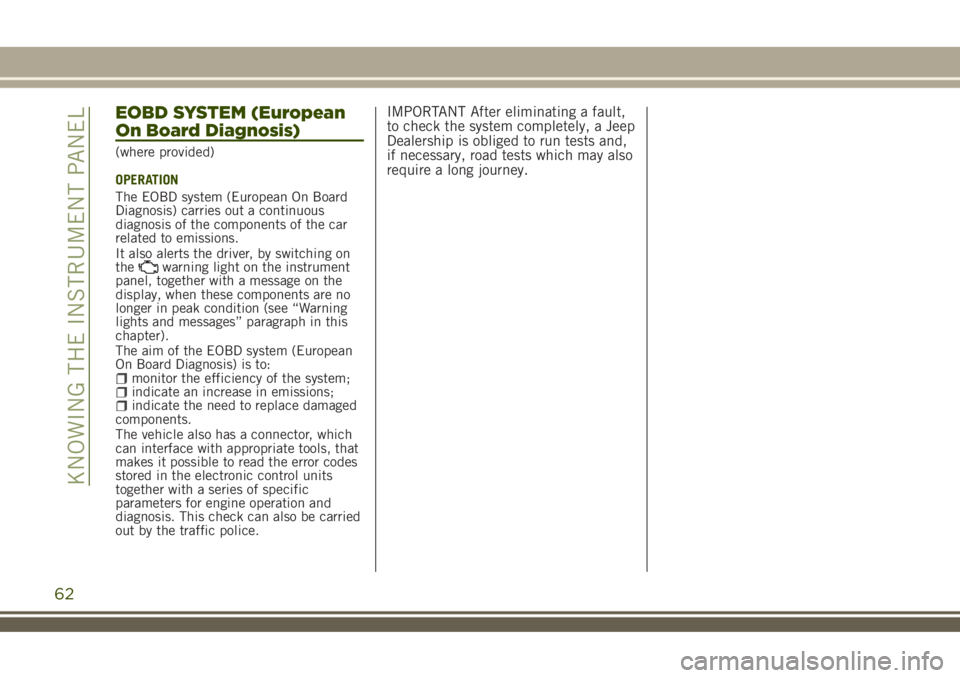
EOBD SYSTEM (European
On Board Diagnosis)
(where provided)
OPERATION
The EOBD system (European On Board
Diagnosis) carries out a continuous
diagnosis of the components of the car
related to emissions.
It also alerts the driver, by switching on
the
warning light on the instrument
panel, together with a message on the
display, when these components are no
longer in peak condition (see “Warning
lights and messages” paragraph in this
chapter).
The aim of the EOBD system (European
On Board Diagnosis) is to:
monitor the efficiency of the system;indicate an increase in emissions;indicate the need to replace damaged
components.
The vehicle also has a connector, which
can interface with appropriate tools, that
makes it possible to read the error codes
stored in the electronic control units
together with a series of specific
parameters for engine operation and
diagnosis. This check can also be carried
out by the traffic police.
IMPORTANT After eliminating a fault,
to check the system completely, a Jeep
Dealership is obliged to run tests and,
if necessary, road tests which may also
require a long journey.
62
KNOWING THE INSTRUMENT PANEL
Page 76 of 356
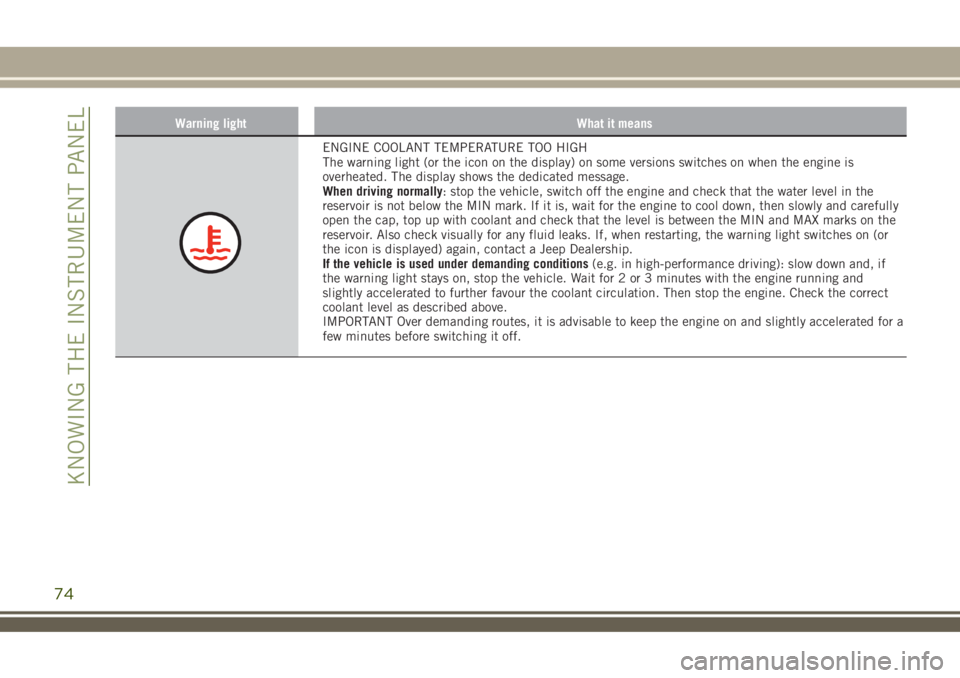
Warning light What it means
ENGINE COOLANT TEMPERATURE TOO HIGH
The warning light (or the icon on the display) on some versions switches on when the engine is
overheated. The display shows the dedicated message.
When driving normally: stop the vehicle, switch off the engine and check that the water level in the
reservoir is not below the MIN mark. If it is, wait for the engine to cool down, then slowly and carefully
open the cap, top up with coolant and check that the level is between the MIN and MAX marks on the
reservoir. Also check visually for any fluid leaks. If, when restarting, the warning light switches on (or
the icon is displayed) again, contact a Jeep Dealership.
If the vehicle is used under demanding conditions(e.g. in high-performance driving): slow down and, if
the warning light stays on, stop the vehicle. Wait for 2 or 3 minutes with the engine running and
slightly accelerated to further favour the coolant circulation. Then stop the engine. Check the correct
coolant level as described above.
IMPORTANT Over demanding routes, it is advisable to keep the engine on and slightly accelerated for a
few minutes before switching it off.
74
KNOWING THE INSTRUMENT PANEL
Page 85 of 356
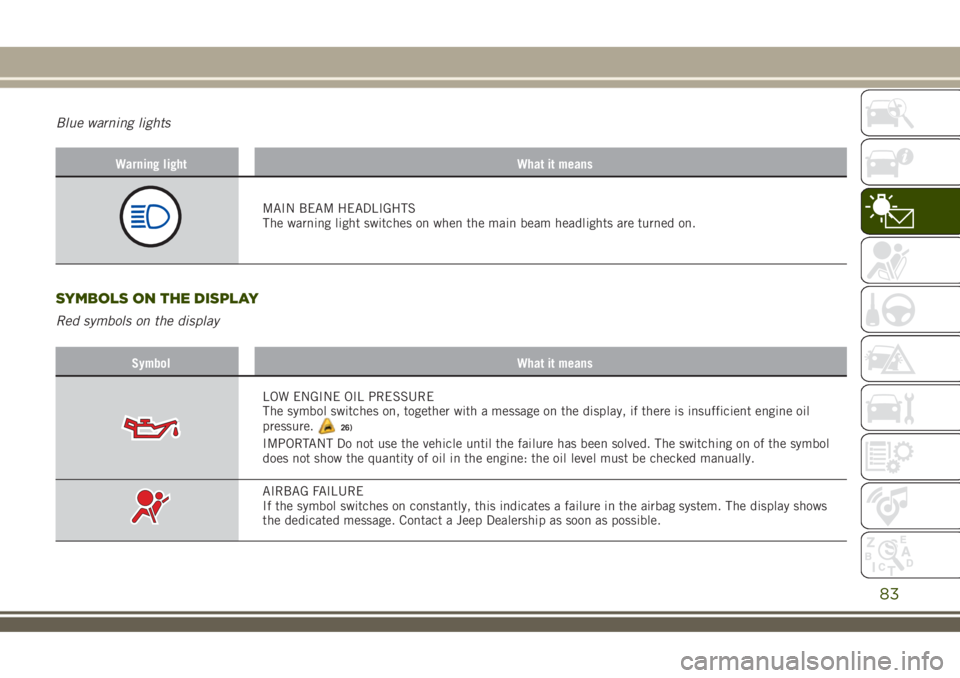
Blue warning lights
Warning light What it means
MAIN BEAM HEADLIGHTS
The warning light switches on when the main beam headlights are turned on.
SYMBOLS ON THE DISPLAY
Red symbols on the display
Symbol What it means
LOW ENGINE OIL PRESSURE
The symbol switches on, together with a message on the display, if there is insufficient engine oil
pressure.
26)
IMPORTANT Do not use the vehicle until the failure has been solved. The switching on of the symbol
does not show the quantity of oil in the engine: the oil level must be checked manually.
AIRBAG FAILURE
If the symbol switches on constantly, this indicates a failure in the airbag system. The display shows
the dedicated message. Contact a Jeep Dealership as soon as possible.
83
Page 113 of 356

putting the ignition device in the MAR
position.
IMPORTANT The system status can be
changed with vehicle at a standstill
only.
Activation/deactivation
If the Forward Collision Warning Plus
system has been correctly activated with
theUconnect™system, this will be active
each time the engine is started.
To deactivate the system, hold down the
button on the central tunnel. Following
a deactivation, the system will not warn
the driver about the possible collision
with the preceding vehicle, regardless of
the setting selected with the
Uconnect™system. To reactivate the
system press the
button again.
The system is only active if:
it is activated via the
Uconnect™system;
it has not been deactivated with a long
press of thebutton;the ignition device is at MAR;the vehicle speed is between 7 and
200 km/h;
the front seat belts are fastened.System limited operation warning
If the dedicated message is displayed, a
condition limiting the system operation
may have occurred. The possible reasons
of this limitation are something blocking
the camera view or a fault. If an
obstruction is signalled, clean the area of
the windscreen indicated in fig. 75 and
check that the message has disappeared.
In this case the system might be not
completely available.
When the conditions limiting the system
functions end, this will go back to normal
and complete operation. Should the fault
persist, contact a Jeep Dealership.
Driving in special conditions
In certain driving conditions, such as, for
example:
driving close to a bend fig. 76;vehicles with small dimensions and/or
not aligned in the driving lane fig. 77;
lane change by other vehicles fig. 78;vehicles travelling at right angles to
the vehicle fig. 79;system intervention might be unexpected
or delayed. The driver must be very
careful to maintain control of the vehicle
and drive in complete safety.
76J0A0081C
77J0A0082C
111